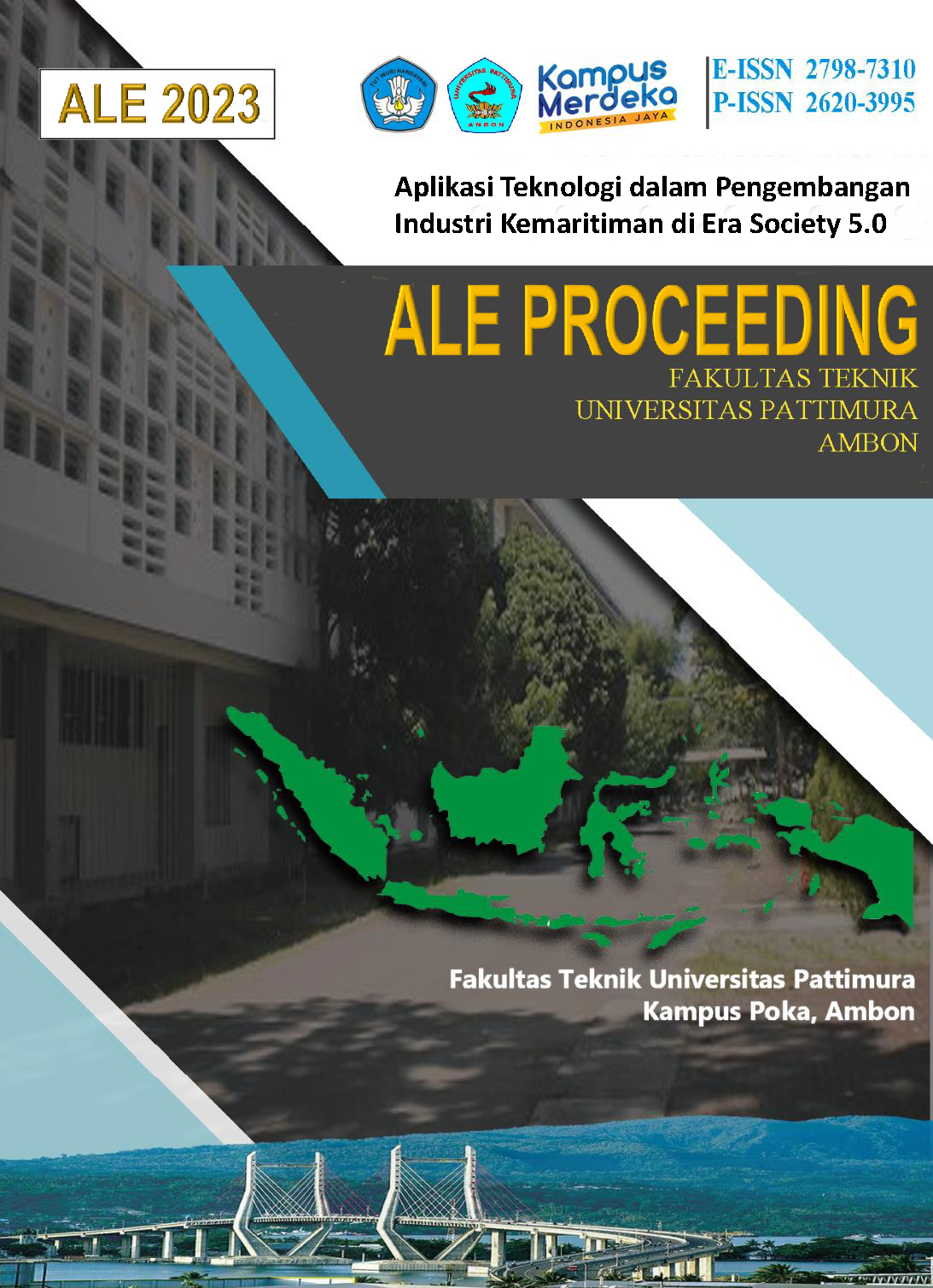DESAIN STRATEGI BISNIS UD. ARSITA: PENERAPAN INVIVO DALAM COMPETITIVE FIVE FORCE (C5F)
Abstract
Tantangan yang dihadapi UD. Arsita mencakup lingkup pasar yang terbatas di Kecamatan Teluk Ambon, adanya produk-produk sejenis di pasar dan kecenderungan dari konsumen membeli produk pesaing baru di pasar. Inisiatif perusahaan membuka 2 pabrik roti baru untuk perluasan pasar, belum dapat memaksimalkan keuntungan yang ditargetkan. Penelitian ini dilakukan untuk menyajikan rancangan strategi bisnis baru yang kompetitif menggunakan pendekatan C5F. Data hasil wawancara terhadap pimpinan dan seluruh karyawan diolah menggunakan metode Nvivo untuk mengidentifikasi strategi menurut komponen C5F. Hasil penelitian berupa 20 strategi bisnis kompetitif mencakup 9 strategi ancaman pendatang baru, 3 strategi ancaman produk atau jasa pengganti, 2 strategi kekuatan penawaran pemasok, 4 strategi kekuatan penawaran pembeli, dan 2 strategi persaingan industri.
Downloads
References
N. H. Tien, P. P. Phu dan D. T. P. Chi, “The role of international marketing in international business strategy,“ International Journal of Research in Marketing Management and Sales, 1(2), 134-138, 2019.
M. Silva dan B. Nunes, “Institutional logic for sustainable purchasing and supply management: Concepts, illustrations, and implications for business strategy,“ Business Strategy and the Environment, 31(3), 1138-1151, 2022.
R. Ambarwati, A. G. Fathurochman dan A. Rizal, “Competitive Force Model for Indopipe Industry with Analysis of Customer Requirements,“ Journal of Physics: Conference SeriesI, 1424 012046, 2019.
F. Rangkuti, Analisis SWOT: Teknik Mem-bedah kasus Bisnis, PT. Gramedia Pustaka Utama, Jakarta, 2005.
M. A. Hitt, R. D. Ireland, dan R. E. Ho-skisson, Strategic Management: Competi-tiveness and Globalization, 7th Edition, Thomson South-Western, Ohio, 2007.
G. A. Steiner, Strategic Planning: What Every Manager Must Know, Free Press, 1979.
P. Cichocki dan C. Irwin, Organizational Design: a Guide to Building Effectiveness Organizations, Kogan Page Limited, Lon-don, 2011.
A. Kates dan J. R. Galbraith, Designing Your Organization: Using the Star Model to Solve 5 Critical Design Challenges, Jossey-Bass, California, 2007.
M. E. Porter, Competitive Advantage: Cre-ating and Sustaining Superior Perfor-mance. Free Press, New York, 1998.
J. R. Jones, Organizational Theory, De-sign, and Change, Fifth Edition, Pearson Education Inc., New Jersey, 2007
G. Johnson, R. Whittington, K. Scholes, D. Angwin dan P. Regner, Exploring Strate-gy: Text and Cases, Eleventh Edition, Pearson Education Limited, Harlow, 2017.
X. Islami, N. Mustafa dan M. T. Latkovikj, “Linking Porter’s generic strategies to firm performance,” Future Business Journal, 6 (1): 3, 1-15, 2020
F. Dälken, “Are Porter’s Five Competitive Forces Still Applicable? A Critical Examination Concerning the Relevance for Today’s Business“, in Proc. 3rd IBA Bachelor Thesis Conference, July 3rd 2014, pp. 1-9.
M. E. Porter, “The structure within industries and companies' performance,“ The Review of Economics and Statistics, 61(2), 214-227, 1979.
M. E. Porter, “The five competitive forces that shape strategy,” Harvard Business Review, 25-40, 1996.
T. Kraiwanit, P. Limna dan S. Siripipatthanakul, “Nvivo for social science and manage-ment studies: a systematic review.” Ad-vance Knowledge for Executives, 2(3), 22, 1-11, 2023.
S. Røddesnes, H. C. Faber dan M. R. Jensen, “Nvivo courses in the library: working to create the library services of tomorrow,“ Nordic Journal of Information Literacy in Higher Education, 11(1), 27-38, 2019.
A. M. Hilal dan S. S. Alabri, “ Using Nvivo for data analysis in qualitative research,“ International Interdisciplinary Journal of Education, 2(2), 181-186, 2013.
X. Feng dan L. Behar-Horenstein, “Maximizing Nvivo Utilities to Analyze OpenEnded Responses,“ The Quality Report, 24(3), 563-571, 2019.
R. T. Putri, D. Novirani dan D. Kur-niawan, “Formulasi strategi menghadapi persaingan industri kuliner pada eins bistro & boutique di Bandung,“ Jurnal Online Institut Teknologi Nasional, 2(3), 127-137, 2015.
F. Harnoto, “Strategi kepuasan pelanggan dalam mempertahankan dan meningkat-kan loyalitas pelanggan,” Jurnal Ekonomi Manajemen dan Akuntansi, 21(36), 1-15, 2014.
A. S. N. Dasril dan S. Y. Kusumastuti, “In-tensitas persaingan industri pengolahan makanan di Indonesia,” MIMBAR Jurnal Sosial dan Pembangunan, 30(20, 127-136, 2014.
P. J. Foris, “Analisis strategi pada perus-ahaan plastik dengan Porter five force,” Agora, 3(1), 736-741, 2015.
D. Lestari, Analisis Kompetensi Keunggu-lan Kompetitif Telkom Fleksi Pasca Migrasi Frekuensi, Diss. Thesis Magister Teknik Elektro, Universitas Indonesia, 2007.
L. Laitanussifa dan A. Muhib, “Strategi pengembangan usaha cake buah naga se-bagai ikon oleh-oleh asli Batam (studi ka-sus: CV Aroma Cake Buah Naga, Ba-tam),” Agribusiness Journal, 12(1), 32-41, 2019.
R. Muftuhah dan H. Rafsanjani, “Pelati-han strategi pemasaran melalui media online pada produk usaha rumahan krupuk bawang dan kripik sukun di desa Cendoro kec. Palang kab. Tuban,” Jurnal Ekonomi dan Perbankan Syariah, 3(2), 227-235, 2019.
Copyright (c) 2023 Victor O Lawalata, Wilma Latuny, Nyong Faturachman Laisi

This work is licensed under a Creative Commons Attribution-ShareAlike 4.0 International License.
An author who publishes in the ALE Proceeding agrees to the following terms:
- Author retains the copyright and grants ALE Proceeding the right of first publication of the work simultaneously licensed under the Creative Commons Attribution-ShareAlike 4.0 License that allows others to share the work with an acknowledgment of the work's authorship and initial publication in this journal.
- Author is able to enter into separate, additional contractual arrangements for the non-exclusive distribution of the journal's published version of the work (e.g., post it to an institutional repository or publish it in a book) with the acknowledgment of its initial publication in this journal.
- Author is permitted and encouraged to post his/her work online (e.g., in institutional repositories or on their website) prior to and during the submission process, as it can lead to productive exchanges, as well as earlier and greater citation of the published work (See The Effect of Open Access).
Read more about the Creative Commons Attribution-ShareAlike 4.0 Licence here: https://creativecommons.org/licenses/by-sa/4.0/.






